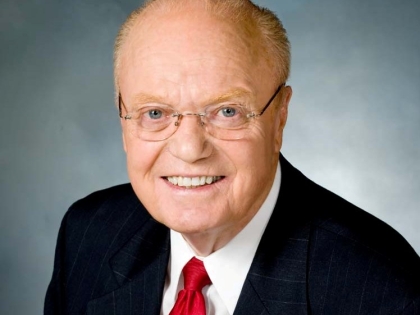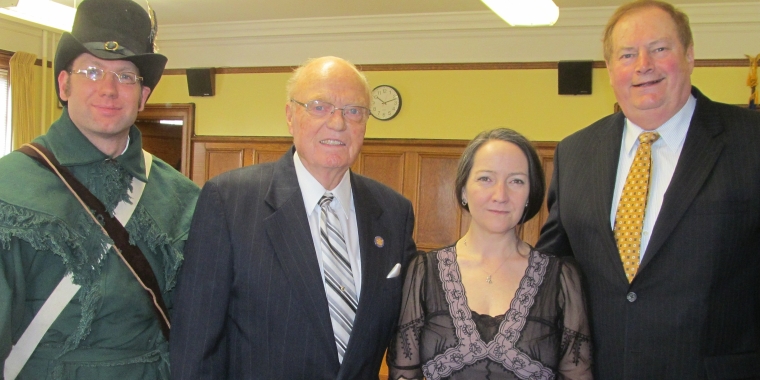
Sen. Farley And Gov. Pataki Announce World's First Demonstration Of High-capacity Superconducting Power Cable On Live Utility Grid
State Senator Hugh T. Farley (R, C - Schenectady) joins Governor George E. Pataki in announcing that a new high-temperature superconducting (HTS) power cable developed by a partnership of companies, including SuperPower, Inc. of Schenectady, has been energized and will be monitored on the local utility grid for the first time anywhere in the world.
This live-grid demonstration is an important step in the development of cutting-edge technologies to meet increasing energy demands in large cities. The HTS cable deployed in Albany is able to carry 3 to 5 times more current than conventional power lines of the same thickness.
Also today, the Long Island Power Authority (LIPA) held a groundbreaking ceremony in Holtsville, Suffolk County, to announce the construction of a half mile HTS cable system, which will be installed in 2007.
"New York State is a national leader in promoting advanced energy technologies that are helping to protect our environment, improve our energy security, and encourage sustainable economic development," Governor Pataki said. "We are committed to supporting innovative projects like this superconducting cable that have great potential to enhance reliability and provide additional, affordable power for utility customers. By investing in new energy technologies like renewable fuels and alternative energy projects, and partnering with visionary companies, we are building a brighter energy future for all New Yorkers."
Senator Farley said, "The capacity and reliability of our electric utility grid is vital to New York's economic development efforts, and is just as important for us average citizens who rely on electricity for our air-conditioners, refrigerators, and stoves. I'm thrilled that this ‘Made in Schenectady’ superconducting cable is an important component of the twenty-first century energy system, and I commend Governor Pataki for his commitment to efficient and sustainable energy resources."
Assemblyman Ron Canestrari said, "We must continue to examine alternatives for more efficient and reliable energy distribution. It’s encouraging to know that New York State and our Capital District is host to a top notch, high-tech company like the Latham-based Intermagnetics General Corporation. Their ground-breaking technology holds much promise for utilities across the nation seeking dependable, safe and efficient ways to deliver electricity to our communities."
Assemblyman Paul D. Tonko, chairman of the Assembly Committee on Energy said, "As we near the three-year anniversary after the Blackout of 2003, we are constantly reminded of the vulnerability of the state and nation’s electric grid. Superpower is on the cutting edge of superconducting technology, which will help ensure the reliability and enhance the efficiency of our energy delivery system. I look forward to the company developing and manufacturing the technology in the ‘Electric City’ – Schenectady, New York!"
Albany County Executive Mike Breslin said, "This project has made our region a model in the development of superconducting power technology. This innovative break-through will make energy delivery more efficient and affordable and will bring tremendous economic opportunity to our community."
The Governor was joined at the event at National Grid’s North Albany Service Center by officials from SuperPower, Inc., Sumitomo Electric Industries, National Grid, the BOC Group, the U.S. Department of Energy, and the New York State Energy Research and Development Authority (NYSERDA), who all played a role in the development of this advanced power cable. NYSERDA has contributed $6.7 million toward this $27 million demonstration project.
In addition, Senator Hugh Farley obtained a $5 million grant for the "Schenectady Superconducting Wire Consortium, which includes SuperPower, Union College, and Schenectady Community College. The grant will assist these organizations in moving high-tech products from the research and development stage to commercial production, while also helping to train highly-skilled productions workers for these specialized applications.
SuperPower, Inc., a subsidiary of Intermagnetics General Corporation, has partnered with Japan’s Sumitomo Electric Industries, the BOC Group, and National Grid to fabricate and install a 350-meter section of underground cable between the National Grid Riverside and Menands substations in North Albany. The BOC Group built the cryogenic refrigeration system (CRS) to cool the cables. The operation of the HTS cable will be monitored continuously by BOC’s Remote Operations Center. The U.S. Department of Energy also contributed more than $13 million to the four-year demonstration project.
The high-temperature superconducting (HTS) cable technology offers the potential to provide numerous benefits over existing technology. In addition to being able to carry a greater load, the cables are also lighter and easier to install and handle, and will deliver power at lower voltages, reducing the need for step-up and step-down transformers. The cables use liquid nitrogen for cooling, rather than flammable oils, which will help to prevent fires or explosions in the event of a leak or overload. The HTS devices also are more electrically efficient, which can help to reduce line losses and generation demand that can produce greenhouse gas emissions.
The commissioning of the cable marks the world’s first demonstration of an underground HTS cable system in a live utility grid, rather than in a lab, or industrial or substation settings. The project also is the first demonstration of a cable-to-cable joint, critical to ensuring that long lengths of cable will be able to be installed.
The success of this pivotal project will be another significant step toward convincing the nation’s utility companies that HTS technology can provide important improvements for the power grid. In addition, SuperPower’s successful participation in the product market for superconductivity applications and products, which the U.S. Department of Energy has estimated will amount to $30 billion by 2020, will generate important economic benefits for New York State.
Major cities with extensive underground cable routes are key prospects for this technology. By keeping the new cable technology at the same diameter as existing cables, replacement of the cables through existing conduits will be an important construction-saving factor.
The Albany superconducting cable will be operated as part of the National Grid system over the next year. Real world utility concerns about implementing a new technology, including maintenance, reliability, and compatibility with the existing grid, will be evaluated. During a second phase of the project, SuperPower will provide the second generation coated conductor HTS wire that will be fabricated into a cable that will then be retrofitted and tested on a 30-meter section of the cable system.
Philip J. Pellegrino, president of SuperPower, said "The success of this technology on the electric power grid has the potential to provide enormous economic development benefits for New York State by way of investment for the manufacture of SuperPower’s 2G HTS wire and the highly skilled and highly paid new jobs that would result."
Peter R. Smith, President of NYSERDA said, "This project exemplifies the kind of technology we fund to improve our energy future, while providing potentially significant economic development opportunities and environmental benefits."
William F. Edwards, New York president of National Grid said, "This project is another example of NYSERDA leadership in energy research and innovation. National Grid is pleased to join them as a partner in demonstrating the promising potential of this new technology."
SuperPower Inc. uses core capabilities in materials, cryogenics and magnetics to develop state-of-the-art second-generation high-temperature superconducting wire and electric power components for underground transmission and distribution cables, transformers, motors, generators and fault current limiters.



